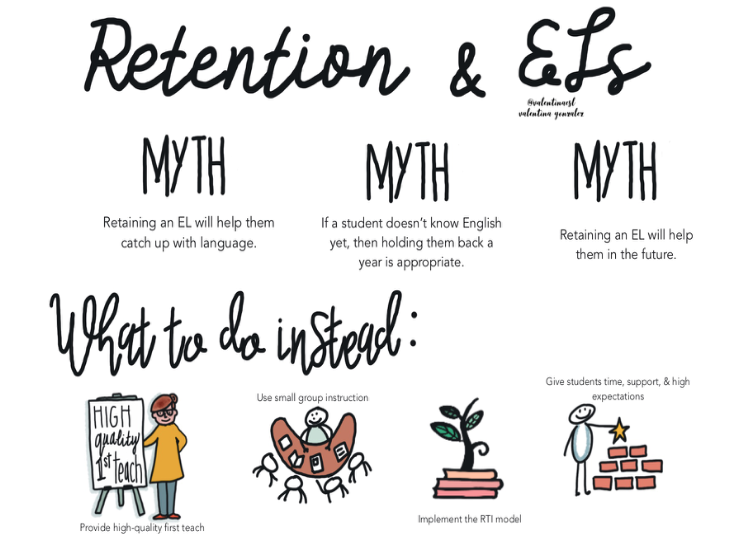EL Retention Myths and What to Do Instead
A MiddleWeb Blog
 The pressure to retain students can be fierce. It can come from various angles…state assessments, classroom grades, administration, and more.
The pressure to retain students can be fierce. It can come from various angles…state assessments, classroom grades, administration, and more.
And it’s right around this time of year (the spring semester) that the school system begins to buzz with the possibility of retention.
Personally speaking, my brother was a product of retention in first grade. Growing up, I witnessed his own struggles with education. It’s unfortunate that retention did not solve his linguistic or academic gaps. In fact, he is a statistic. My brother dropped out of high school his senior year.
Professionally, I have been the teacher who has retained a student. I vividly remember sitting in a parent-teacher conference and discussing academic progress and state assessments. I will never forget looking into that parent’s eyes and telling them that their child would have to repeat another year of this grade level.
I’m not an advocate for retention. Retention is much like a bandage. It’s reactive rather than proactive. And when it comes to students who are not yet fully English proficient, we must proceed with even more caution when faced with the possibility of retention.
Common Myths about Retaining ELs
Myth #1: Retaining an EL will help them catch up with language.
Here’s a word of caution. Don’t think of retention as an additional year to learn English. On the contrary, think of it as a year lost. Based on the landmark Supreme Court ruling in Lau v. Nichols (1974), if an EL is held back solely on the basis of lack of English proficiency, this would be considered discriminatory. (See the this quick video explanation of Lau v. Nichols from Colorin Colorado.)
Myth #2: If a student doesn’t know English yet, then holding them back a year is appropriate.

Second language acquisition takes time. While social language can be acquired within one to three years, the more complex academic language can take four to seven years (Echevarria, Vogt, Short, 2017).
Myth #3: Retaining an EL will help them in the future.
John Hattie’s research finds that retention has reverse effects (2016). Rather than increasing students’ success, retention works to do the exact opposite. Repeating the same grade level, the same curriculum, the same way, can discourage and demotivate students.
NPR reports that English learners continue to lag academically. If we look at the gap between the total of students who graduate and the total of ELs that graduate from state to state, we have to question why some gaps are so large. On the other hand, we should be looking closely at the states that have smaller gaps or where ELs are doing better than “all students.”
Instead of retention, try these options:
1. Provide high quality the first time through!
The quality of instruction that our students receive is completely under our control as educators. English learners (no matter if they are newcomers, SIFE, LTELs, or other) benefit most from classrooms that are language rich.
The best teachers of ELs include instruction that is highly engaging, relevant, and completely comprehensible to students. Characteristics of these classrooms are:
• Multiple entry points for students (visual, auditory, kinesthetic, etc.)
• Employment of all language domains (listening, speaking, reading, and writing)
• Opportunities for students to show understanding
• Frequent opportunities for feedback from the teacher
• Student choice and voice in learning and products
2. Use small group instruction.
Yes, even in secondary classrooms, small group instruction can be a game changer. Small group instruction can be used a few times a week to refine, reteach, and enrich student learning. It does not need to be a daily practice nor does it need to take an entire class period. Small groups should be flexible, meaning that groups change based on student needs.
After whole group instruction, formatively assess student comprehension. Perhaps have students write a Ticket Out. Then make 3 groups out of the Tickets Out: Got It, Need a Little Support, and Need a Reteach. The following day, while students are working independently, gather the students who Need Reteach (based on the Tickets Out) and reteach the lesson in a small group direct instruction.
According to Hattie, small group learning is within the zone of desired effects as long as grouping is flexible and not fixed.
3. Implement the RtI for ELs model.
RTI (also known as MTSS) is a multi-tiered, systematic approach to instruction. I remember when I was first introduced to RTI as a teacher, I honestly didn’t get it and I’m sure I wasn’t the only one. The way it was explained was so vague and cumbersome. Every time it was brought up, shoulders seemed to slump.
Only years later did I learn that RTI (Response to Intervention) or MTSS (Multi-Tiered System of Supports) is simply a planned out, targeted approach to instruction. It includes universal screening, progress monitoring, evidence-based instruction, evidence-based interventions, data-based problem solving and decision-making, shared teaming and leadership, and fidelity of implementation of evidence-based practices (Haas & Brown, 2019).
4. Give students time, support, and high expectations.
As mentioned earlier, English acquisition takes time. It takes longer for some students than for others. Whatever the student’s situation may be, we can create conditions in our classrooms that either stifle language development or help it to flourish. Creating a safe space for students to feel as if they can take risks, be who they are, and make mistakes will certainly pay off in the end both academically and emotionally.
This article, Holding High, Not Hurried, Expectations by Barbara Gottschalk is excellent and has a nice chart on the difference between the high and the hurried expectation. The support we give our English learners as they develop English and learn content makes a difference. We can:
• Provide opportunities for peer to peer interaction
• Offer sentence stems
• Use visuals while teaching
• Offer adapted texts
• Use gestures
• Scaffold writing tasks
• Provide word banks or word walls
But most of all, we can remember that we set the ceiling for our students. They will rise to our expectations. What we believe about our students impacts their success. So how high is your ceiling?
Proceed with Caution
Before retaining an English Learner, always ask yourself these questions:
► Is there a reason other than English proficiency that the student may qualify for retention?
► Has the student been provided high quality, adequate instruction with linguistic accommodations that meet the child’s language proficiency?
► What specific interventions have been implemented to support the student?
► What are the district’s guidelines or policies for retention? Are there specific guidelines or policies governing English learners?
And remember, don’t imagine that retention is simply “an extra year to learn English.” It’s not.
References
Echevarría Jana, Vogt, M. E., & Short, D. (2017). Making content comprehensible for English learners: The SIOP Model. Boston: Pearson.
Fisher, D., Frey, N., & Hattie, J. A. C. (2016). Visible learning for literacy: Implementing the practices that work best to accelerate student learning, Grades K-12. Thousand Oaks (California): Corwin.
Gottschalk, Barbara. (2019, December). Holding High, Not Hurried, Expectations for ELLs. ASCD Education Update.
Haas, E., & Brown, J. E. (2019). Supporting English learners in the classroom: Best practices for distinguishing language acquisition from learning disabilities. New York, NY: Teachers College Press.
Sanchez, C. (2017, February 23). English Language Learners: How Your State Is Doing. National Public Radio.
When You Believe In Your Students They Do Better. (n.d.). YouCubed.org





































Amanda – thanks for asking! We’ve added a PDF download link at the end of the article. Readers are welcome to use it for personal reference and discussions with colleagues.
Hey, Valentina!
What a thoughtful and honest article about retention. Thank you for sharing your brother’s experience and that of the student who you retained. We do this work to right our past wrongs, right? I sure am!
I appreciated how you structured this as myths and alternatives to retention! We are so lucky to have you in our PLN! Keep shining so brightly!
While I loved this article and agree with this 99% of the time, I have been part of a committee that retained a Kindergarten student. He came into the US during the 2nd half of the year, missed the cutoff for pre-K by 11 days, and had only 60 days of school in the US before everything shut down for Covid-19.
In his particular situation, retention helped him as he was thriving the next year in Kindergarten. During his repeat K year he was then the same age as his peers rather than a year younger. Normally, I don’t recommend retention, especially at higher grade levels, but this student’s particular retention situation helped him thrive.
Thank you for sharing this unique circumstance, M.G. I appreciate your dedication to being an advocate for what’s best for your students and knowing their individual needs.